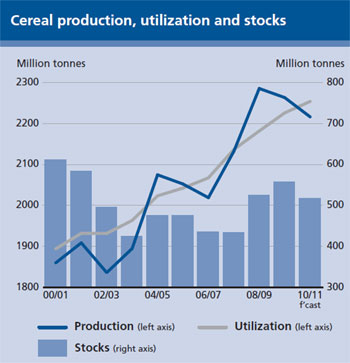Contrary to earlier predictions, world cereal production is now forecast to contract by two percent rather than to expand by 1.2 percent as anticipated in June. Unexpected supply shortfalls due to unfavourable weather events were responsible for this change in direction, according to the report.
Global cereal stocks are forecast to decline sharply and Food Outlook makes a strong call for production to be stepped up to replenish inventories. World cereals stocks are anticipated to shrink by seven percent according to FAO, with barley plunging 35 percent, maize 12 percent and wheat 10 percent.

FAO Outlook. November 2010.
Unexpected production shortfalls driven by weather events negatively influenced the outlook for global cereal supply in the early months of the 2010/11 marketing season from July to October. Rarely have markets exhibited this level of uncertainty and sudden turns in such a brief period of time. World cereal production this year, which is currently put at 2 216 million tonnes, is 2 percent below the previous year’s level and, although it represents the third largest crop on record, it is 63 million tonnes less than the forecast reported in the June 2010 Food Outlook. Most of the downward revision, involving wheat and coarse grains, following cuts in production in major grain producing countries in the Commonwealth of Independent States (CIS) and disappointing yields in the EU, Canada and the United States.
As production numbers were trimmed, policy responses in the form of export restrictions by some countries also contributed to anxiety in world markets. International prices surged rapidly, renewing worries over the tightening cereal supply and demand balance. In recent weeks, developments in other food markets and the slide in the US Dollar have further underpinned cereal prices and volatility. Against this background, the size of next year’s
harvest becomes increasingly critical. For stocks to be replenished and prices to return to more normal levels, large production expansions are needed in 2011, especially for wheat and major coarse grains.
http://www.fao.org/docrep/013/al969e/al969e00.pdf



